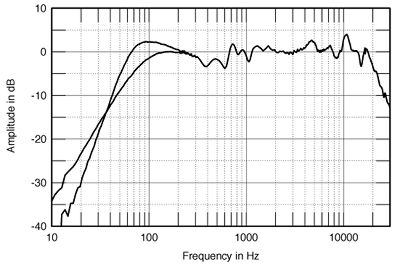| Columns Retired Columns & Blogs |
Mission m71 loudspeaker Measurements
Sidebar 3: Measurements
The little Mission m71 is quite sensitive, 2.83V raising a B-weighted SPL of 88.5dB(B) at 1m. It is also moderately easy to drive, with an impedance (fig.1) that drops to just below 4 ohms in the lower midrange and an electrical phase angle that exceeds 30 degrees only when the impedance magnitude is fairly high. The saddle at 58Hz in the magnitude trace indicates the tuning of the rear-facing port.

Fig.1 Mission m71, electrical impedance (solid) and phase (dashed). (2 ohms/vertical div.)
Although it won't be seen at the scale this graph is printed in the magazine, there are some very slight discontinuities in the impedance traces at 600Hz and 1.1kHz, these usually indicative of resonances of some sort at these frequencies. Fig.2 shows a cumulative spectral-decay plot calculated from the output of a simple plastic-tape accelerometer fastened to the cabinet sidewall. A ridge of delayed energy due to a panel resonance can be seen at 600Hz, but there is also a higher-level mode apparent at 484Hz. Although high in level, these might also be too high in frequency to have much of a deleterious effect on the Mission's sound quality.

Fig.2 Mission m71, cumulative spectral-decay plot of accelerometer output fastened to center of side panel. (MLS driving voltage to speaker, 7.55V; measurement bandwidth, 2kHz.)
While a slight spike at 1.1kHz exists in this graph, it is too low in level, I would have thought, to have any effect on the speaker's measured impedance. However, look at fig.3, which shows the individual outputs of the tweeter, woofer, and port. The port's output is the bandpass curve neatly covering the midbass region, but look at what happens in the midrange. There is a small peak apparent at 600Hz, but the response continues to rise above that frequency, and is still rising at the 1kHz limit of this measurement.

Fig.3 Mission m71, acoustic crossover on woofer axis at 50", with the nearfield woofer and port responses plotted below 300Hz and 1kHz, respectively.
I don't analyze my speaker measurements until after I have put all my acoustic measuring equipment away, otherwise I would have repeated this nearfield measurement with a signal of wider bandwidth. However, I suspect that the port output peaks at around 1.1kHz, which is the same frequency as both the very slight discontinuity in the impedance traces and a suspicious-looking suckout in the woofer's on-axis response.
Higher in frequency, the m71's woofer peaks a little before handing over to the tweeter at the specified 2.8kHz crossover frequency. The tweeter can also be seen to be a little peaky on-axis in the top octave of its passband. Fig.4 shows how the individual woofer and port responses sum in the farfield, spliced to the overall output averaged across a 30 degrees horizontal window on the woofer axis. Give or take a few little bumps, the m71's response is respectably smooth in the treble and well-integrated through the crossover region.

Fig.4 Mission m71, anechoic response on woofer axis at 50", averaged across 30 degrees horizontal window and corrected for microphone response, with the complex sum of the nearfield woofer and port outputs (top at 100Hz), and the nearfield response of the woofer with the port sealed (bottom at 100Hz), plotted below 300Hz.
- Log in or register to post comments




































